Holmes Institute HI6028 Taxation Law Case Study Assignment T1 2019
VerifiedAdded on 2022/11/24
|10
|2497
|308
Homework Assignment
AI Summary
This document presents a detailed solution to a Taxation Law case study assignment completed for the HI6028 unit at Holmes Institute. The assignment addresses various taxation issues, including the application of Capital Gains Tax (CGT) to the sale of collectables like paintings, sculptures, and jewelry, and the determination of assessable income from personal exertion, such as writing a book. The solution analyzes different scenarios, citing relevant sections of the Income Tax Assessment Act 1997 and 1936, and relevant case law to support its conclusions. It covers topics like CGT events, the definition of collectables, and the treatment of income from personal exertion. The document provides a comprehensive breakdown of each issue, including the applicable rules, their application to the specific facts, and a final conclusion, demonstrating a clear understanding of Australian taxation law principles.
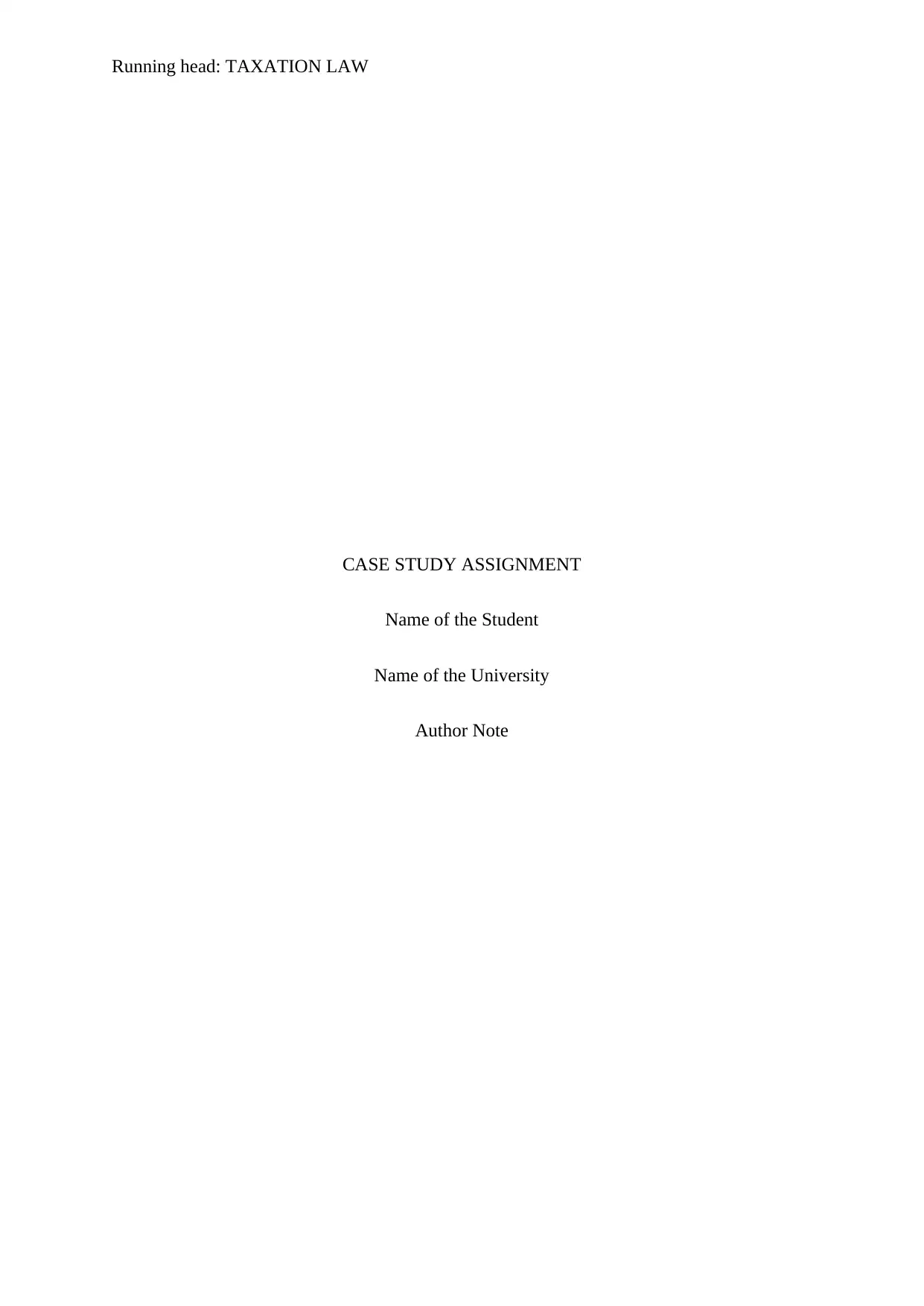
Running head: TAXATION LAW
CASE STUDY ASSIGNMENT
Name of the Student
Name of the University
Author Note
CASE STUDY ASSIGNMENT
Name of the Student
Name of the University
Author Note
Paraphrase This Document
Need a fresh take? Get an instant paraphrase of this document with our AI Paraphraser
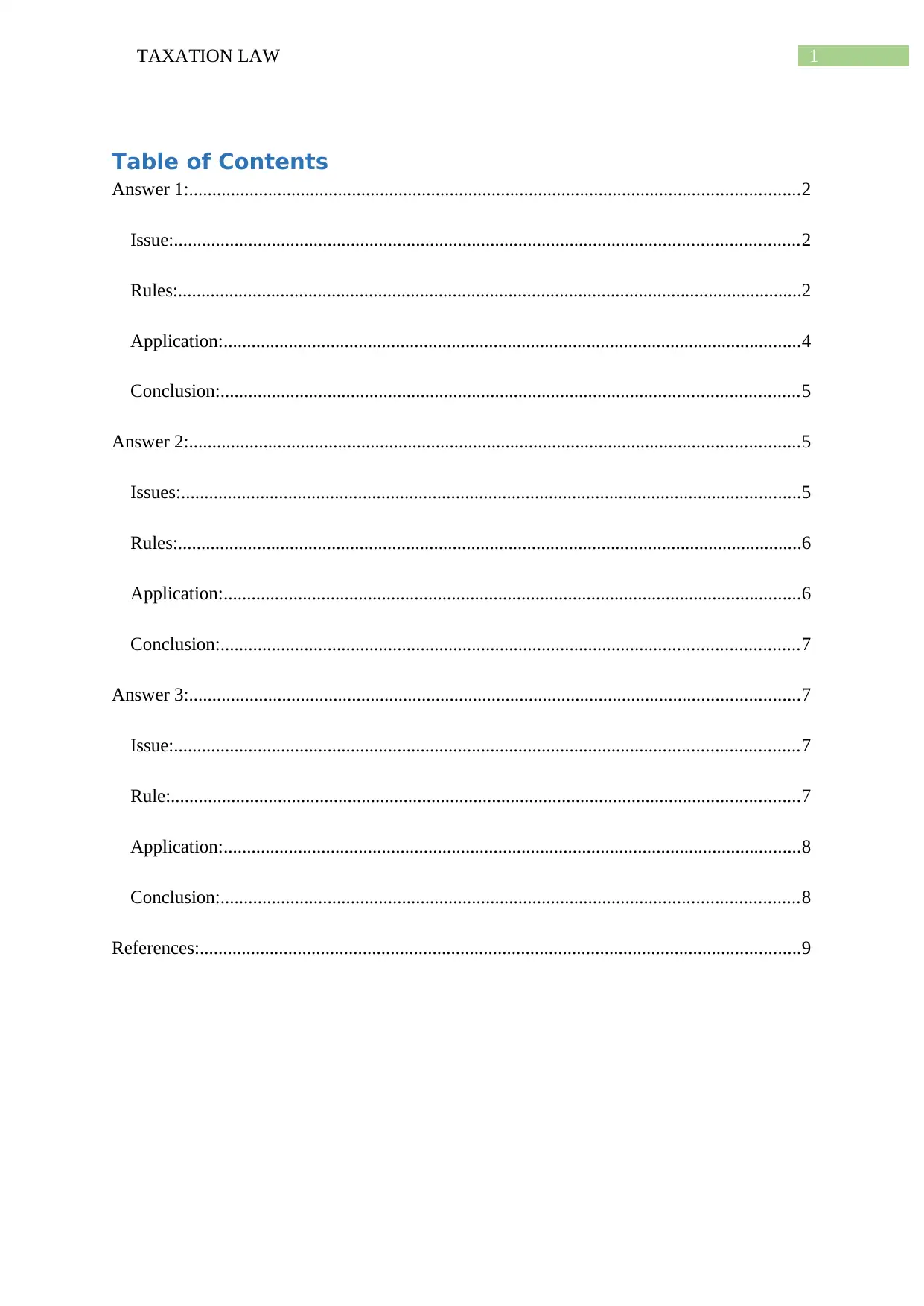
1TAXATION LAW
Table of Contents
Answer 1:...................................................................................................................................2
Issue:......................................................................................................................................2
Rules:......................................................................................................................................2
Application:............................................................................................................................4
Conclusion:............................................................................................................................5
Answer 2:...................................................................................................................................5
Issues:.....................................................................................................................................5
Rules:......................................................................................................................................6
Application:............................................................................................................................6
Conclusion:............................................................................................................................7
Answer 3:...................................................................................................................................7
Issue:......................................................................................................................................7
Rule:.......................................................................................................................................7
Application:............................................................................................................................8
Conclusion:............................................................................................................................8
References:.................................................................................................................................9
Table of Contents
Answer 1:...................................................................................................................................2
Issue:......................................................................................................................................2
Rules:......................................................................................................................................2
Application:............................................................................................................................4
Conclusion:............................................................................................................................5
Answer 2:...................................................................................................................................5
Issues:.....................................................................................................................................5
Rules:......................................................................................................................................6
Application:............................................................................................................................6
Conclusion:............................................................................................................................7
Answer 3:...................................................................................................................................7
Issue:......................................................................................................................................7
Rule:.......................................................................................................................................7
Application:............................................................................................................................8
Conclusion:............................................................................................................................8
References:.................................................................................................................................9
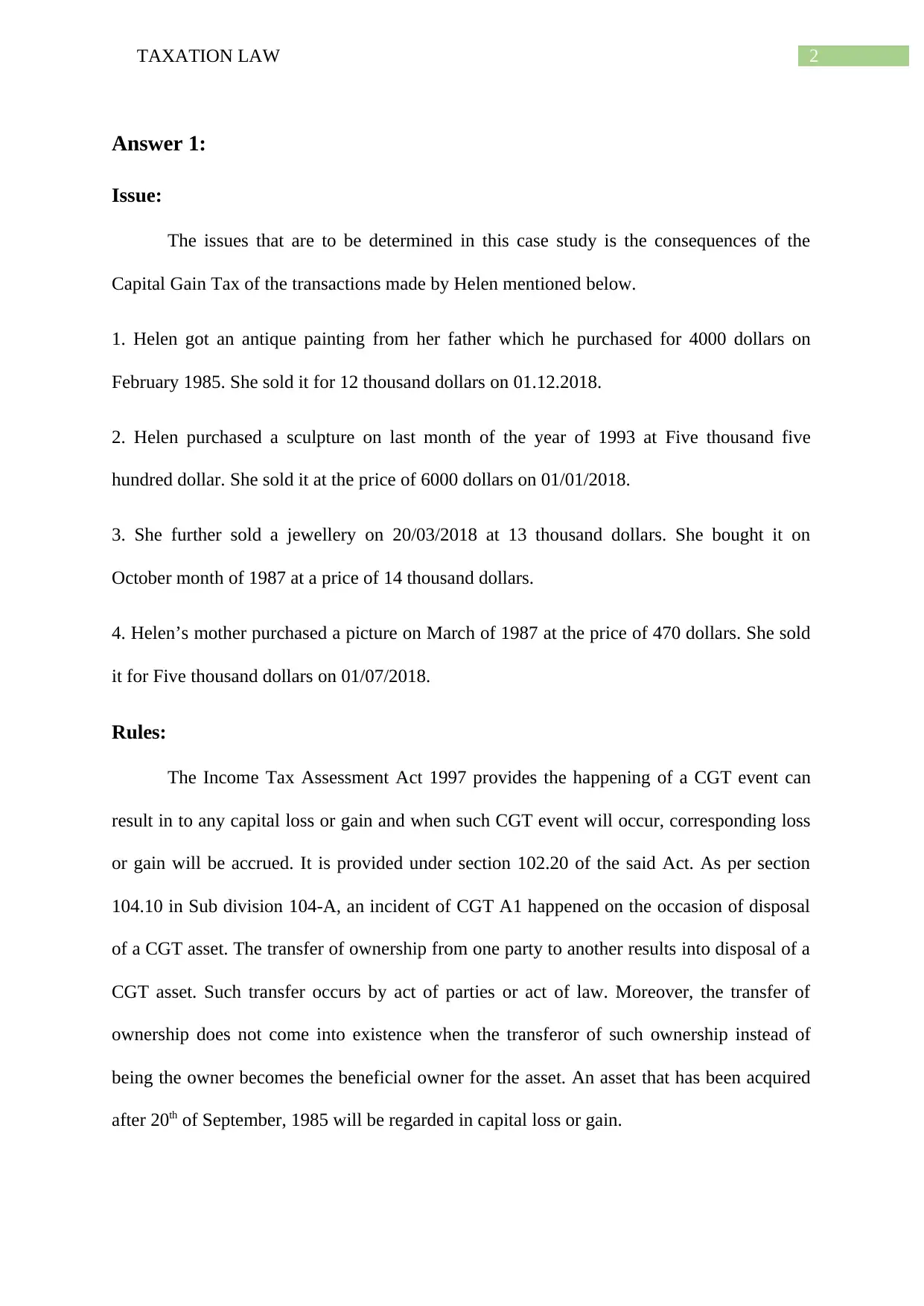
2TAXATION LAW
Answer 1:
Issue:
The issues that are to be determined in this case study is the consequences of the
Capital Gain Tax of the transactions made by Helen mentioned below.
1. Helen got an antique painting from her father which he purchased for 4000 dollars on
February 1985. She sold it for 12 thousand dollars on 01.12.2018.
2. Helen purchased a sculpture on last month of the year of 1993 at Five thousand five
hundred dollar. She sold it at the price of 6000 dollars on 01/01/2018.
3. She further sold a jewellery on 20/03/2018 at 13 thousand dollars. She bought it on
October month of 1987 at a price of 14 thousand dollars.
4. Helen’s mother purchased a picture on March of 1987 at the price of 470 dollars. She sold
it for Five thousand dollars on 01/07/2018.
Rules:
The Income Tax Assessment Act 1997 provides the happening of a CGT event can
result in to any capital loss or gain and when such CGT event will occur, corresponding loss
or gain will be accrued. It is provided under section 102.20 of the said Act. As per section
104.10 in Sub division 104-A, an incident of CGT A1 happened on the occasion of disposal
of a CGT asset. The transfer of ownership from one party to another results into disposal of a
CGT asset. Such transfer occurs by act of parties or act of law. Moreover, the transfer of
ownership does not come into existence when the transferor of such ownership instead of
being the owner becomes the beneficial owner for the asset. An asset that has been acquired
after 20th of September, 1985 will be regarded in capital loss or gain.
Answer 1:
Issue:
The issues that are to be determined in this case study is the consequences of the
Capital Gain Tax of the transactions made by Helen mentioned below.
1. Helen got an antique painting from her father which he purchased for 4000 dollars on
February 1985. She sold it for 12 thousand dollars on 01.12.2018.
2. Helen purchased a sculpture on last month of the year of 1993 at Five thousand five
hundred dollar. She sold it at the price of 6000 dollars on 01/01/2018.
3. She further sold a jewellery on 20/03/2018 at 13 thousand dollars. She bought it on
October month of 1987 at a price of 14 thousand dollars.
4. Helen’s mother purchased a picture on March of 1987 at the price of 470 dollars. She sold
it for Five thousand dollars on 01/07/2018.
Rules:
The Income Tax Assessment Act 1997 provides the happening of a CGT event can
result in to any capital loss or gain and when such CGT event will occur, corresponding loss
or gain will be accrued. It is provided under section 102.20 of the said Act. As per section
104.10 in Sub division 104-A, an incident of CGT A1 happened on the occasion of disposal
of a CGT asset. The transfer of ownership from one party to another results into disposal of a
CGT asset. Such transfer occurs by act of parties or act of law. Moreover, the transfer of
ownership does not come into existence when the transferor of such ownership instead of
being the owner becomes the beneficial owner for the asset. An asset that has been acquired
after 20th of September, 1985 will be regarded in capital loss or gain.
⊘ This is a preview!⊘
Do you want full access?
Subscribe today to unlock all pages.

Trusted by 1+ million students worldwide
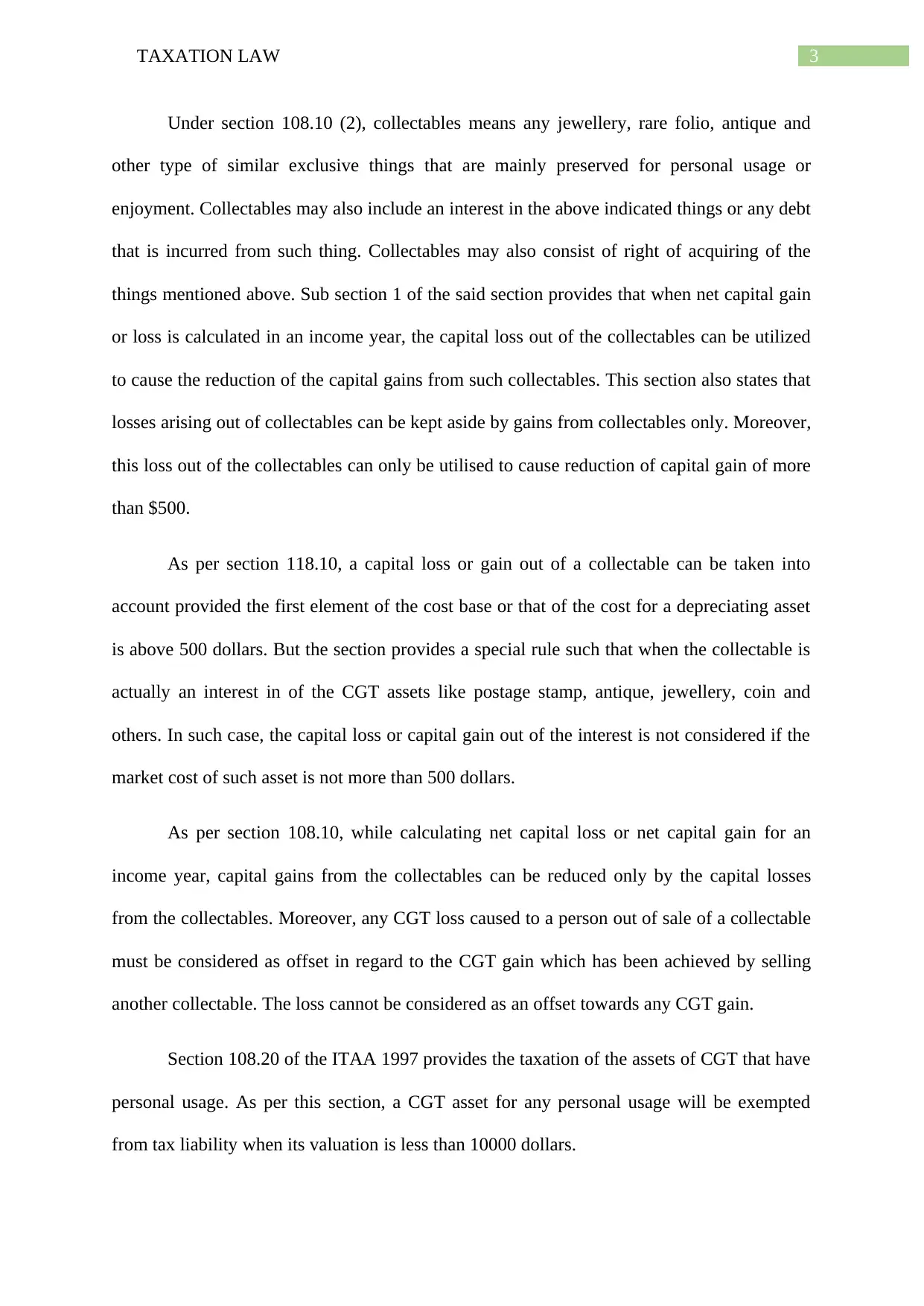
3TAXATION LAW
Under section 108.10 (2), collectables means any jewellery, rare folio, antique and
other type of similar exclusive things that are mainly preserved for personal usage or
enjoyment. Collectables may also include an interest in the above indicated things or any debt
that is incurred from such thing. Collectables may also consist of right of acquiring of the
things mentioned above. Sub section 1 of the said section provides that when net capital gain
or loss is calculated in an income year, the capital loss out of the collectables can be utilized
to cause the reduction of the capital gains from such collectables. This section also states that
losses arising out of collectables can be kept aside by gains from collectables only. Moreover,
this loss out of the collectables can only be utilised to cause reduction of capital gain of more
than $500.
As per section 118.10, a capital loss or gain out of a collectable can be taken into
account provided the first element of the cost base or that of the cost for a depreciating asset
is above 500 dollars. But the section provides a special rule such that when the collectable is
actually an interest in of the CGT assets like postage stamp, antique, jewellery, coin and
others. In such case, the capital loss or capital gain out of the interest is not considered if the
market cost of such asset is not more than 500 dollars.
As per section 108.10, while calculating net capital loss or net capital gain for an
income year, capital gains from the collectables can be reduced only by the capital losses
from the collectables. Moreover, any CGT loss caused to a person out of sale of a collectable
must be considered as offset in regard to the CGT gain which has been achieved by selling
another collectable. The loss cannot be considered as an offset towards any CGT gain.
Section 108.20 of the ITAA 1997 provides the taxation of the assets of CGT that have
personal usage. As per this section, a CGT asset for any personal usage will be exempted
from tax liability when its valuation is less than 10000 dollars.
Under section 108.10 (2), collectables means any jewellery, rare folio, antique and
other type of similar exclusive things that are mainly preserved for personal usage or
enjoyment. Collectables may also include an interest in the above indicated things or any debt
that is incurred from such thing. Collectables may also consist of right of acquiring of the
things mentioned above. Sub section 1 of the said section provides that when net capital gain
or loss is calculated in an income year, the capital loss out of the collectables can be utilized
to cause the reduction of the capital gains from such collectables. This section also states that
losses arising out of collectables can be kept aside by gains from collectables only. Moreover,
this loss out of the collectables can only be utilised to cause reduction of capital gain of more
than $500.
As per section 118.10, a capital loss or gain out of a collectable can be taken into
account provided the first element of the cost base or that of the cost for a depreciating asset
is above 500 dollars. But the section provides a special rule such that when the collectable is
actually an interest in of the CGT assets like postage stamp, antique, jewellery, coin and
others. In such case, the capital loss or capital gain out of the interest is not considered if the
market cost of such asset is not more than 500 dollars.
As per section 108.10, while calculating net capital loss or net capital gain for an
income year, capital gains from the collectables can be reduced only by the capital losses
from the collectables. Moreover, any CGT loss caused to a person out of sale of a collectable
must be considered as offset in regard to the CGT gain which has been achieved by selling
another collectable. The loss cannot be considered as an offset towards any CGT gain.
Section 108.20 of the ITAA 1997 provides the taxation of the assets of CGT that have
personal usage. As per this section, a CGT asset for any personal usage will be exempted
from tax liability when its valuation is less than 10000 dollars.
Paraphrase This Document
Need a fresh take? Get an instant paraphrase of this document with our AI Paraphraser
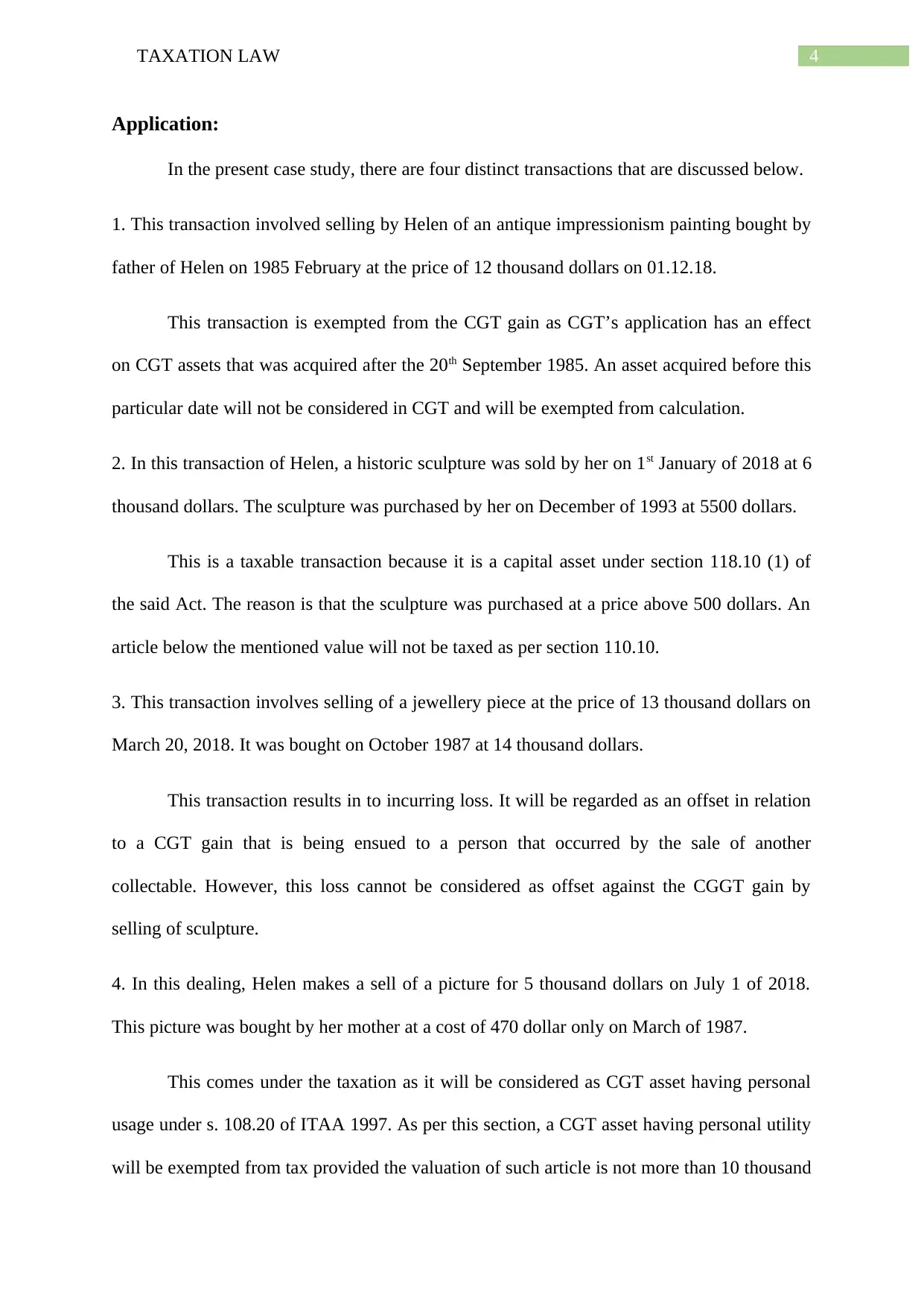
4TAXATION LAW
Application:
In the present case study, there are four distinct transactions that are discussed below.
1. This transaction involved selling by Helen of an antique impressionism painting bought by
father of Helen on 1985 February at the price of 12 thousand dollars on 01.12.18.
This transaction is exempted from the CGT gain as CGT’s application has an effect
on CGT assets that was acquired after the 20th September 1985. An asset acquired before this
particular date will not be considered in CGT and will be exempted from calculation.
2. In this transaction of Helen, a historic sculpture was sold by her on 1st January of 2018 at 6
thousand dollars. The sculpture was purchased by her on December of 1993 at 5500 dollars.
This is a taxable transaction because it is a capital asset under section 118.10 (1) of
the said Act. The reason is that the sculpture was purchased at a price above 500 dollars. An
article below the mentioned value will not be taxed as per section 110.10.
3. This transaction involves selling of a jewellery piece at the price of 13 thousand dollars on
March 20, 2018. It was bought on October 1987 at 14 thousand dollars.
This transaction results in to incurring loss. It will be regarded as an offset in relation
to a CGT gain that is being ensued to a person that occurred by the sale of another
collectable. However, this loss cannot be considered as offset against the CGGT gain by
selling of sculpture.
4. In this dealing, Helen makes a sell of a picture for 5 thousand dollars on July 1 of 2018.
This picture was bought by her mother at a cost of 470 dollar only on March of 1987.
This comes under the taxation as it will be considered as CGT asset having personal
usage under s. 108.20 of ITAA 1997. As per this section, a CGT asset having personal utility
will be exempted from tax provided the valuation of such article is not more than 10 thousand
Application:
In the present case study, there are four distinct transactions that are discussed below.
1. This transaction involved selling by Helen of an antique impressionism painting bought by
father of Helen on 1985 February at the price of 12 thousand dollars on 01.12.18.
This transaction is exempted from the CGT gain as CGT’s application has an effect
on CGT assets that was acquired after the 20th September 1985. An asset acquired before this
particular date will not be considered in CGT and will be exempted from calculation.
2. In this transaction of Helen, a historic sculpture was sold by her on 1st January of 2018 at 6
thousand dollars. The sculpture was purchased by her on December of 1993 at 5500 dollars.
This is a taxable transaction because it is a capital asset under section 118.10 (1) of
the said Act. The reason is that the sculpture was purchased at a price above 500 dollars. An
article below the mentioned value will not be taxed as per section 110.10.
3. This transaction involves selling of a jewellery piece at the price of 13 thousand dollars on
March 20, 2018. It was bought on October 1987 at 14 thousand dollars.
This transaction results in to incurring loss. It will be regarded as an offset in relation
to a CGT gain that is being ensued to a person that occurred by the sale of another
collectable. However, this loss cannot be considered as offset against the CGGT gain by
selling of sculpture.
4. In this dealing, Helen makes a sell of a picture for 5 thousand dollars on July 1 of 2018.
This picture was bought by her mother at a cost of 470 dollar only on March of 1987.
This comes under the taxation as it will be considered as CGT asset having personal
usage under s. 108.20 of ITAA 1997. As per this section, a CGT asset having personal utility
will be exempted from tax provided the valuation of such article is not more than 10 thousand
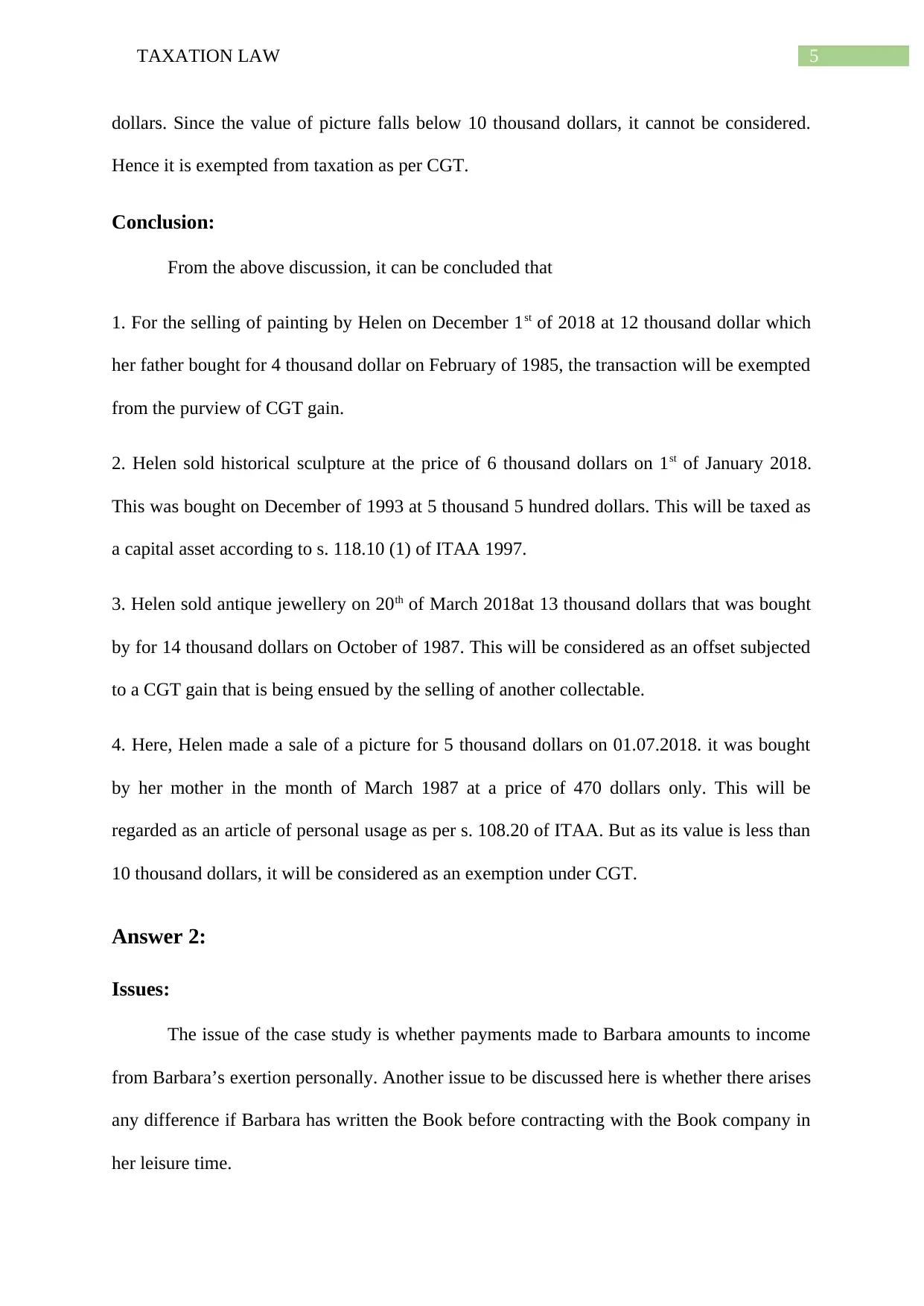
5TAXATION LAW
dollars. Since the value of picture falls below 10 thousand dollars, it cannot be considered.
Hence it is exempted from taxation as per CGT.
Conclusion:
From the above discussion, it can be concluded that
1. For the selling of painting by Helen on December 1st of 2018 at 12 thousand dollar which
her father bought for 4 thousand dollar on February of 1985, the transaction will be exempted
from the purview of CGT gain.
2. Helen sold historical sculpture at the price of 6 thousand dollars on 1st of January 2018.
This was bought on December of 1993 at 5 thousand 5 hundred dollars. This will be taxed as
a capital asset according to s. 118.10 (1) of ITAA 1997.
3. Helen sold antique jewellery on 20th of March 2018at 13 thousand dollars that was bought
by for 14 thousand dollars on October of 1987. This will be considered as an offset subjected
to a CGT gain that is being ensued by the selling of another collectable.
4. Here, Helen made a sale of a picture for 5 thousand dollars on 01.07.2018. it was bought
by her mother in the month of March 1987 at a price of 470 dollars only. This will be
regarded as an article of personal usage as per s. 108.20 of ITAA. But as its value is less than
10 thousand dollars, it will be considered as an exemption under CGT.
Answer 2:
Issues:
The issue of the case study is whether payments made to Barbara amounts to income
from Barbara’s exertion personally. Another issue to be discussed here is whether there arises
any difference if Barbara has written the Book before contracting with the Book company in
her leisure time.
dollars. Since the value of picture falls below 10 thousand dollars, it cannot be considered.
Hence it is exempted from taxation as per CGT.
Conclusion:
From the above discussion, it can be concluded that
1. For the selling of painting by Helen on December 1st of 2018 at 12 thousand dollar which
her father bought for 4 thousand dollar on February of 1985, the transaction will be exempted
from the purview of CGT gain.
2. Helen sold historical sculpture at the price of 6 thousand dollars on 1st of January 2018.
This was bought on December of 1993 at 5 thousand 5 hundred dollars. This will be taxed as
a capital asset according to s. 118.10 (1) of ITAA 1997.
3. Helen sold antique jewellery on 20th of March 2018at 13 thousand dollars that was bought
by for 14 thousand dollars on October of 1987. This will be considered as an offset subjected
to a CGT gain that is being ensued by the selling of another collectable.
4. Here, Helen made a sale of a picture for 5 thousand dollars on 01.07.2018. it was bought
by her mother in the month of March 1987 at a price of 470 dollars only. This will be
regarded as an article of personal usage as per s. 108.20 of ITAA. But as its value is less than
10 thousand dollars, it will be considered as an exemption under CGT.
Answer 2:
Issues:
The issue of the case study is whether payments made to Barbara amounts to income
from Barbara’s exertion personally. Another issue to be discussed here is whether there arises
any difference if Barbara has written the Book before contracting with the Book company in
her leisure time.
⊘ This is a preview!⊘
Do you want full access?
Subscribe today to unlock all pages.

Trusted by 1+ million students worldwide
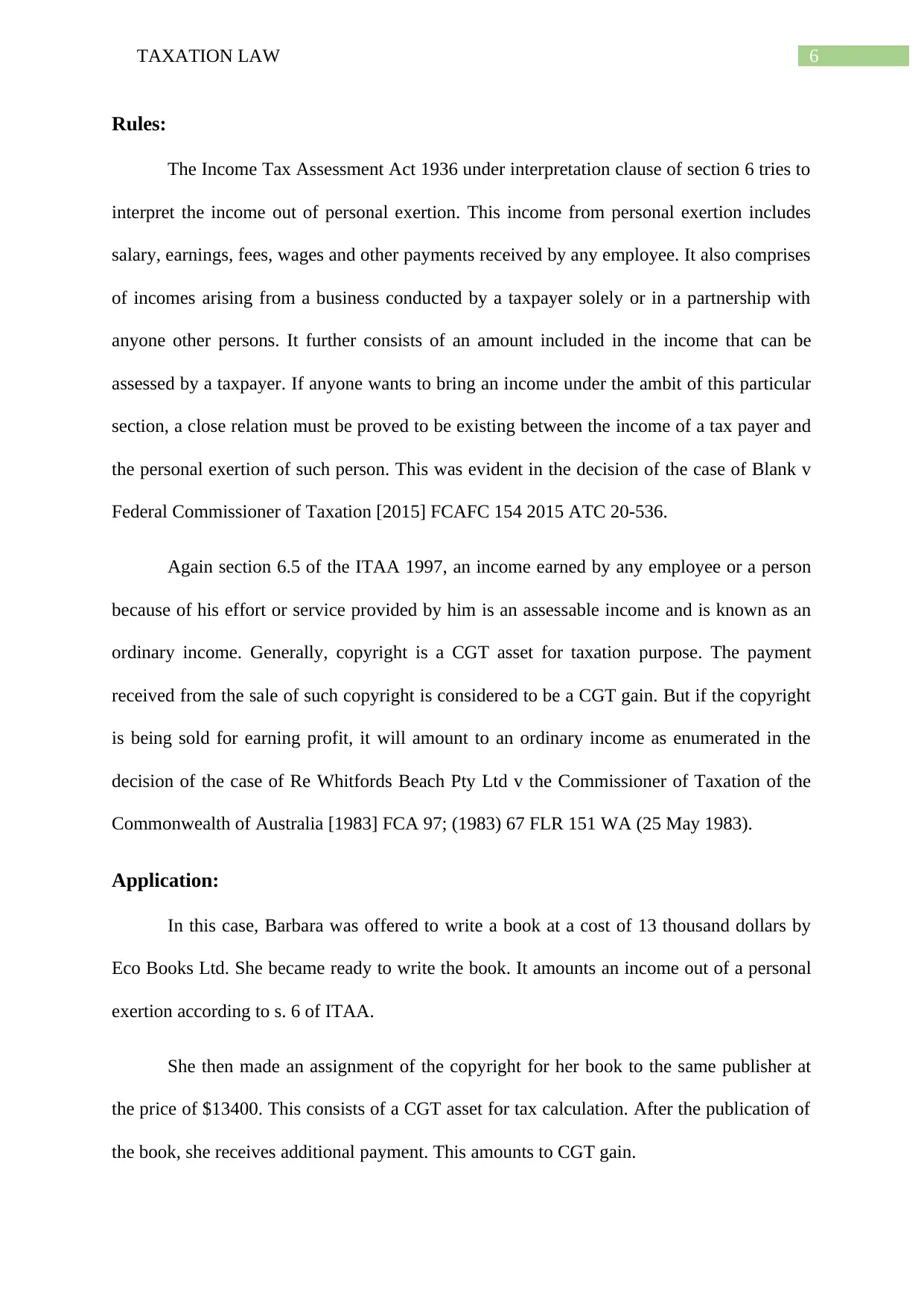
6TAXATION LAW
Rules:
The Income Tax Assessment Act 1936 under interpretation clause of section 6 tries to
interpret the income out of personal exertion. This income from personal exertion includes
salary, earnings, fees, wages and other payments received by any employee. It also comprises
of incomes arising from a business conducted by a taxpayer solely or in a partnership with
anyone other persons. It further consists of an amount included in the income that can be
assessed by a taxpayer. If anyone wants to bring an income under the ambit of this particular
section, a close relation must be proved to be existing between the income of a tax payer and
the personal exertion of such person. This was evident in the decision of the case of Blank v
Federal Commissioner of Taxation [2015] FCAFC 154 2015 ATC 20-536.
Again section 6.5 of the ITAA 1997, an income earned by any employee or a person
because of his effort or service provided by him is an assessable income and is known as an
ordinary income. Generally, copyright is a CGT asset for taxation purpose. The payment
received from the sale of such copyright is considered to be a CGT gain. But if the copyright
is being sold for earning profit, it will amount to an ordinary income as enumerated in the
decision of the case of Re Whitfords Beach Pty Ltd v the Commissioner of Taxation of the
Commonwealth of Australia [1983] FCA 97; (1983) 67 FLR 151 WA (25 May 1983).
Application:
In this case, Barbara was offered to write a book at a cost of 13 thousand dollars by
Eco Books Ltd. She became ready to write the book. It amounts an income out of a personal
exertion according to s. 6 of ITAA.
She then made an assignment of the copyright for her book to the same publisher at
the price of $13400. This consists of a CGT asset for tax calculation. After the publication of
the book, she receives additional payment. This amounts to CGT gain.
Rules:
The Income Tax Assessment Act 1936 under interpretation clause of section 6 tries to
interpret the income out of personal exertion. This income from personal exertion includes
salary, earnings, fees, wages and other payments received by any employee. It also comprises
of incomes arising from a business conducted by a taxpayer solely or in a partnership with
anyone other persons. It further consists of an amount included in the income that can be
assessed by a taxpayer. If anyone wants to bring an income under the ambit of this particular
section, a close relation must be proved to be existing between the income of a tax payer and
the personal exertion of such person. This was evident in the decision of the case of Blank v
Federal Commissioner of Taxation [2015] FCAFC 154 2015 ATC 20-536.
Again section 6.5 of the ITAA 1997, an income earned by any employee or a person
because of his effort or service provided by him is an assessable income and is known as an
ordinary income. Generally, copyright is a CGT asset for taxation purpose. The payment
received from the sale of such copyright is considered to be a CGT gain. But if the copyright
is being sold for earning profit, it will amount to an ordinary income as enumerated in the
decision of the case of Re Whitfords Beach Pty Ltd v the Commissioner of Taxation of the
Commonwealth of Australia [1983] FCA 97; (1983) 67 FLR 151 WA (25 May 1983).
Application:
In this case, Barbara was offered to write a book at a cost of 13 thousand dollars by
Eco Books Ltd. She became ready to write the book. It amounts an income out of a personal
exertion according to s. 6 of ITAA.
She then made an assignment of the copyright for her book to the same publisher at
the price of $13400. This consists of a CGT asset for tax calculation. After the publication of
the book, she receives additional payment. This amounts to CGT gain.
Paraphrase This Document
Need a fresh take? Get an instant paraphrase of this document with our AI Paraphraser
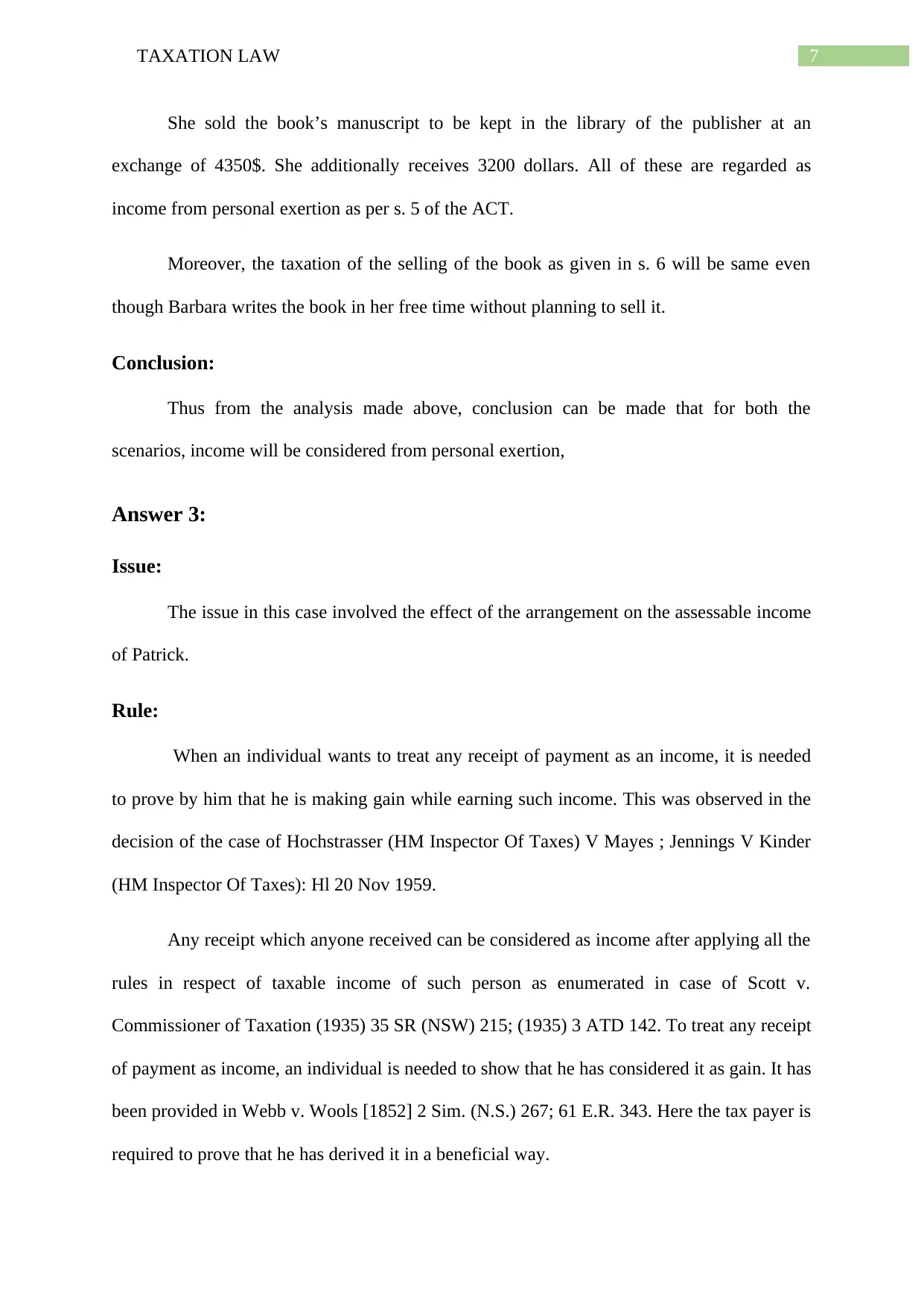
7TAXATION LAW
She sold the book’s manuscript to be kept in the library of the publisher at an
exchange of 4350$. She additionally receives 3200 dollars. All of these are regarded as
income from personal exertion as per s. 5 of the ACT.
Moreover, the taxation of the selling of the book as given in s. 6 will be same even
though Barbara writes the book in her free time without planning to sell it.
Conclusion:
Thus from the analysis made above, conclusion can be made that for both the
scenarios, income will be considered from personal exertion,
Answer 3:
Issue:
The issue in this case involved the effect of the arrangement on the assessable income
of Patrick.
Rule:
When an individual wants to treat any receipt of payment as an income, it is needed
to prove by him that he is making gain while earning such income. This was observed in the
decision of the case of Hochstrasser (HM Inspector Of Taxes) V Mayes ; Jennings V Kinder
(HM Inspector Of Taxes): Hl 20 Nov 1959.
Any receipt which anyone received can be considered as income after applying all the
rules in respect of taxable income of such person as enumerated in case of Scott v.
Commissioner of Taxation (1935) 35 SR (NSW) 215; (1935) 3 ATD 142. To treat any receipt
of payment as income, an individual is needed to show that he has considered it as gain. It has
been provided in Webb v. Wools [1852] 2 Sim. (N.S.) 267; 61 E.R. 343. Here the tax payer is
required to prove that he has derived it in a beneficial way.
She sold the book’s manuscript to be kept in the library of the publisher at an
exchange of 4350$. She additionally receives 3200 dollars. All of these are regarded as
income from personal exertion as per s. 5 of the ACT.
Moreover, the taxation of the selling of the book as given in s. 6 will be same even
though Barbara writes the book in her free time without planning to sell it.
Conclusion:
Thus from the analysis made above, conclusion can be made that for both the
scenarios, income will be considered from personal exertion,
Answer 3:
Issue:
The issue in this case involved the effect of the arrangement on the assessable income
of Patrick.
Rule:
When an individual wants to treat any receipt of payment as an income, it is needed
to prove by him that he is making gain while earning such income. This was observed in the
decision of the case of Hochstrasser (HM Inspector Of Taxes) V Mayes ; Jennings V Kinder
(HM Inspector Of Taxes): Hl 20 Nov 1959.
Any receipt which anyone received can be considered as income after applying all the
rules in respect of taxable income of such person as enumerated in case of Scott v.
Commissioner of Taxation (1935) 35 SR (NSW) 215; (1935) 3 ATD 142. To treat any receipt
of payment as income, an individual is needed to show that he has considered it as gain. It has
been provided in Webb v. Wools [1852] 2 Sim. (N.S.) 267; 61 E.R. 343. Here the tax payer is
required to prove that he has derived it in a beneficial way.
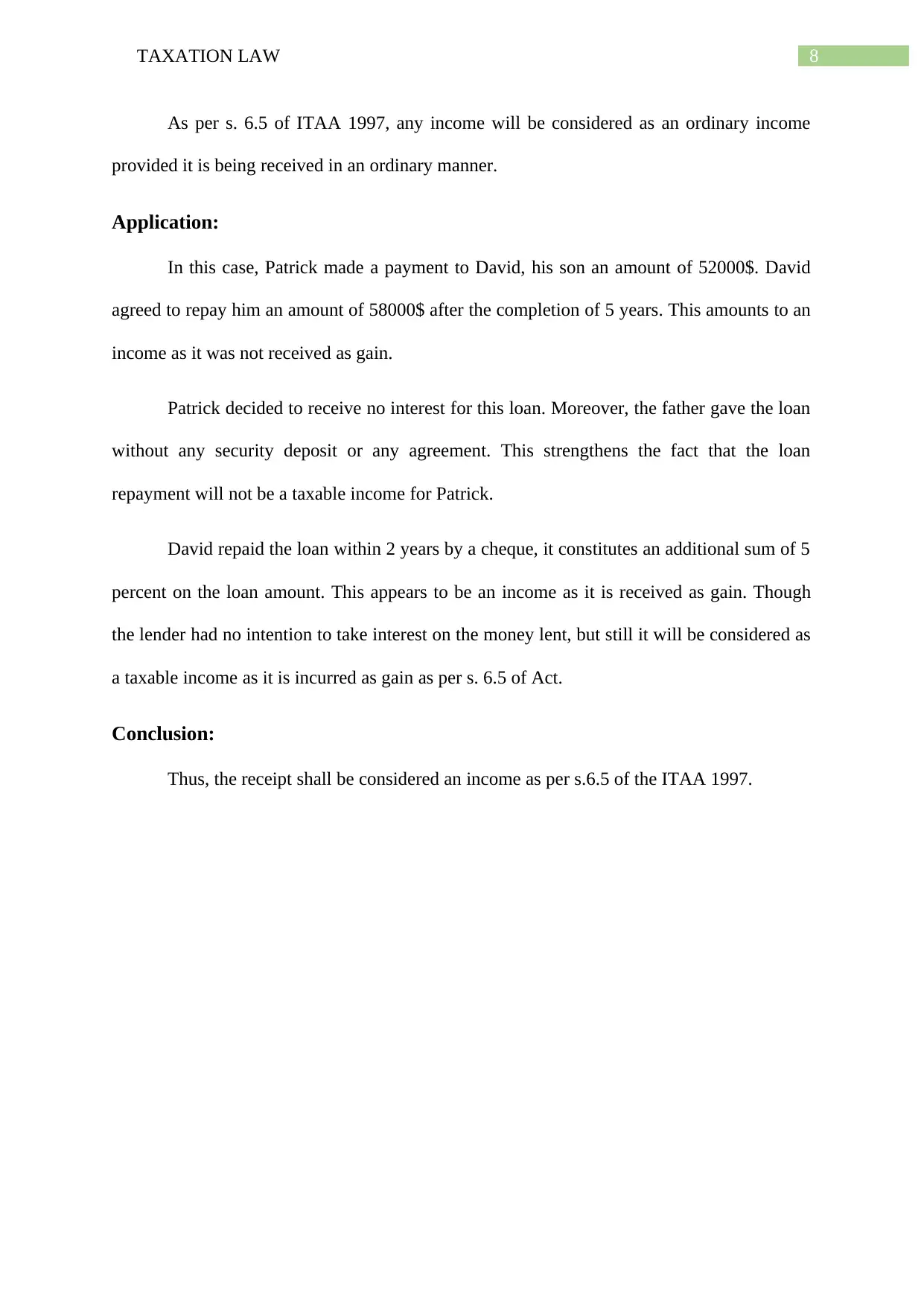
8TAXATION LAW
As per s. 6.5 of ITAA 1997, any income will be considered as an ordinary income
provided it is being received in an ordinary manner.
Application:
In this case, Patrick made a payment to David, his son an amount of 52000$. David
agreed to repay him an amount of 58000$ after the completion of 5 years. This amounts to an
income as it was not received as gain.
Patrick decided to receive no interest for this loan. Moreover, the father gave the loan
without any security deposit or any agreement. This strengthens the fact that the loan
repayment will not be a taxable income for Patrick.
David repaid the loan within 2 years by a cheque, it constitutes an additional sum of 5
percent on the loan amount. This appears to be an income as it is received as gain. Though
the lender had no intention to take interest on the money lent, but still it will be considered as
a taxable income as it is incurred as gain as per s. 6.5 of Act.
Conclusion:
Thus, the receipt shall be considered an income as per s.6.5 of the ITAA 1997.
As per s. 6.5 of ITAA 1997, any income will be considered as an ordinary income
provided it is being received in an ordinary manner.
Application:
In this case, Patrick made a payment to David, his son an amount of 52000$. David
agreed to repay him an amount of 58000$ after the completion of 5 years. This amounts to an
income as it was not received as gain.
Patrick decided to receive no interest for this loan. Moreover, the father gave the loan
without any security deposit or any agreement. This strengthens the fact that the loan
repayment will not be a taxable income for Patrick.
David repaid the loan within 2 years by a cheque, it constitutes an additional sum of 5
percent on the loan amount. This appears to be an income as it is received as gain. Though
the lender had no intention to take interest on the money lent, but still it will be considered as
a taxable income as it is incurred as gain as per s. 6.5 of Act.
Conclusion:
Thus, the receipt shall be considered an income as per s.6.5 of the ITAA 1997.
⊘ This is a preview!⊘
Do you want full access?
Subscribe today to unlock all pages.

Trusted by 1+ million students worldwide
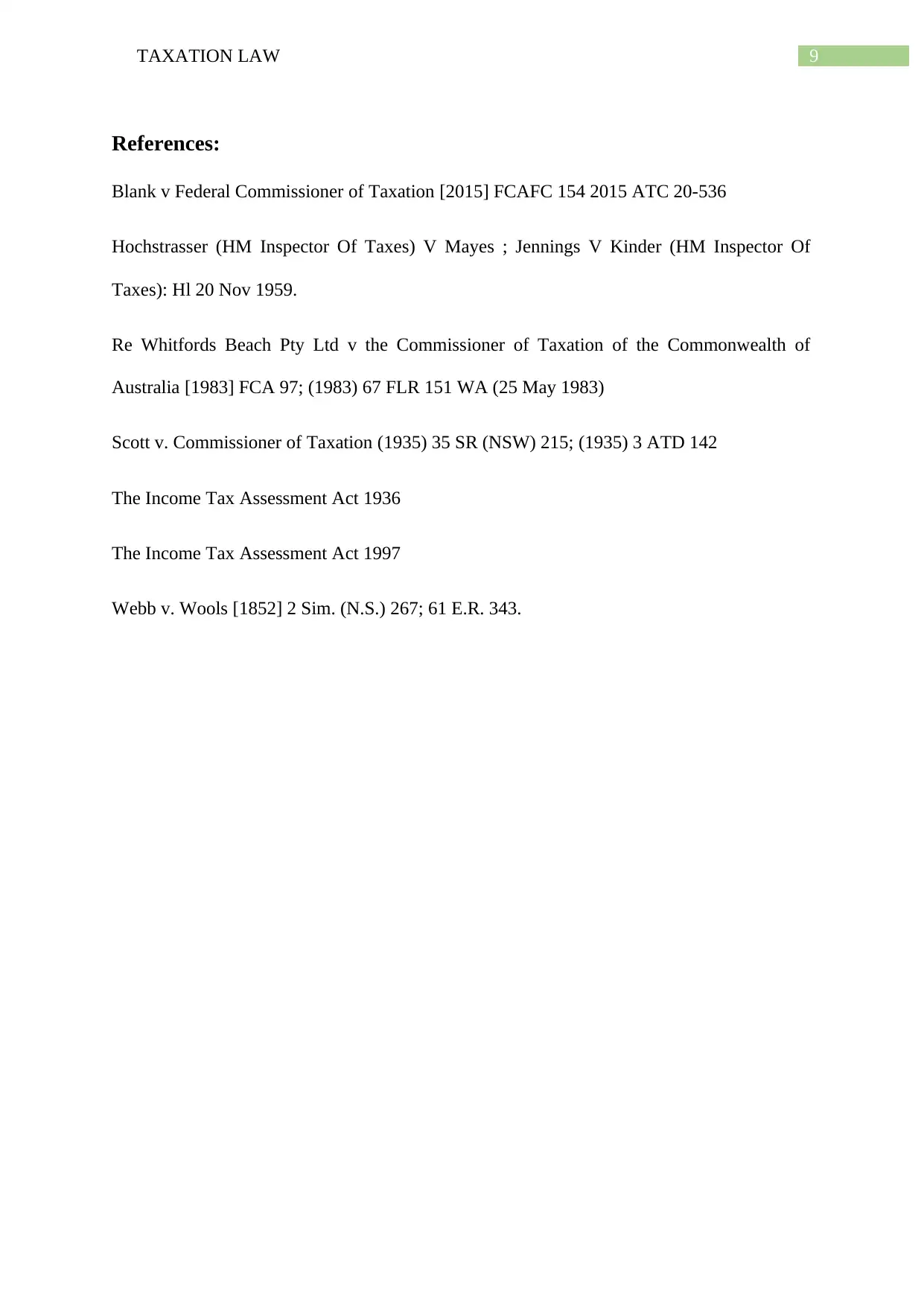
9TAXATION LAW
References:
Blank v Federal Commissioner of Taxation [2015] FCAFC 154 2015 ATC 20-536
Hochstrasser (HM Inspector Of Taxes) V Mayes ; Jennings V Kinder (HM Inspector Of
Taxes): Hl 20 Nov 1959.
Re Whitfords Beach Pty Ltd v the Commissioner of Taxation of the Commonwealth of
Australia [1983] FCA 97; (1983) 67 FLR 151 WA (25 May 1983)
Scott v. Commissioner of Taxation (1935) 35 SR (NSW) 215; (1935) 3 ATD 142
The Income Tax Assessment Act 1936
The Income Tax Assessment Act 1997
Webb v. Wools [1852] 2 Sim. (N.S.) 267; 61 E.R. 343.
References:
Blank v Federal Commissioner of Taxation [2015] FCAFC 154 2015 ATC 20-536
Hochstrasser (HM Inspector Of Taxes) V Mayes ; Jennings V Kinder (HM Inspector Of
Taxes): Hl 20 Nov 1959.
Re Whitfords Beach Pty Ltd v the Commissioner of Taxation of the Commonwealth of
Australia [1983] FCA 97; (1983) 67 FLR 151 WA (25 May 1983)
Scott v. Commissioner of Taxation (1935) 35 SR (NSW) 215; (1935) 3 ATD 142
The Income Tax Assessment Act 1936
The Income Tax Assessment Act 1997
Webb v. Wools [1852] 2 Sim. (N.S.) 267; 61 E.R. 343.
1 out of 10
Related Documents
Your All-in-One AI-Powered Toolkit for Academic Success.
+13062052269
info@desklib.com
Available 24*7 on WhatsApp / Email
![[object Object]](/_next/static/media/star-bottom.7253800d.svg)
Unlock your academic potential
Copyright © 2020–2025 A2Z Services. All Rights Reserved. Developed and managed by ZUCOL.




